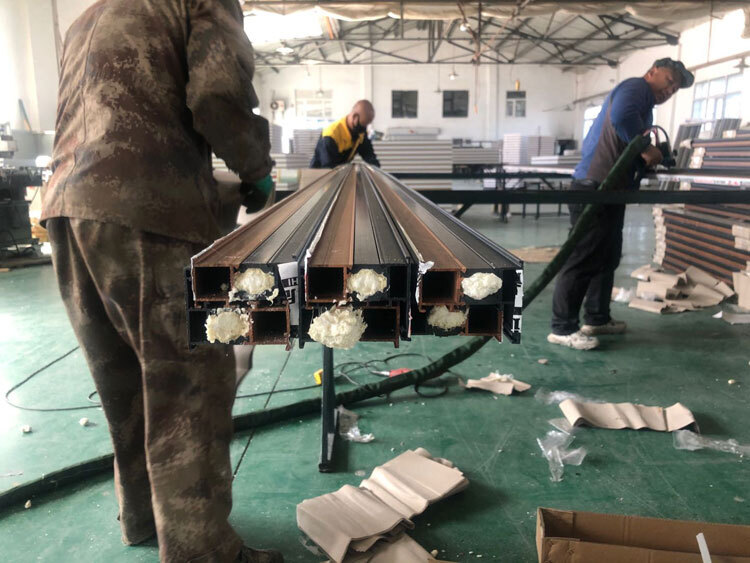What are the requirements for foam use in broken bridge aluminum alloy windows and doors?
- 2017-11-21
- View 29
What are the requirements for foam use in broken bridge aluminum alloy windows and doors?
Generally, the requirements for foam use in broken bridge aluminum alloy windows and doors are density, and there is a choice of timing and quantitative functions for polyurethane pouring foam machines in different regions. For example, models such as JNJX-Q2600D, JNJX-Ⅲ(E), JNJX-H5600(D) and T40D polyurethane foam machine are types of polyurethane foam machines.

JX-H-P30S

JX-H-P30S

JX-H-P30S

JX-H-T40D

JX-H-T40D

JX-H-T40D

The important aspects of foam use in broken bridge aluminum alloy windows and doors include solvent-based polyurethane spraying water-based polyurethane spraying, high-solid polyurethane spraying, and polyurethane powder coating. Polyurethane spraying is used in various industries such as automotive transportation, wood, furniture, industry, construction, textiles, and electronics.
The Asia-Pacific region remains the largest global consumer of polyurethane spraying, with consumption in the Asia-Pacific region accounting for about half of the total global consumption.
In recent years, the Asia-Pacific polyurethane spraying market is expected to maintain steady growth at an annual compound growth rate of 8%, with China being the largest consumer of polyurethane spraying in the world.
Analysts say that due to the different functional divisions of polyurethane spraying, it is estimated that the construction and electronics industries will become the fastest-growing fields in the polyurethane spraying market in the future.
The advantages of polyurethane foam used in broken bridge aluminum alloy windows and doors include:
High closed-cell rate, low thermal conductivity, and high energy-saving efficiency;
Lightweight, safe, and fire-resistant;
Simple and quick construction, short duration, and low cost;
Good integrity, can form a continuous seamless layer on different surfaces;
After use, it can firmly adhere to the surface of the object with high strength;
Long service life.
First, let's understand the installation procedures and construction key points of polyurethane foam machine used in broken bridge aluminum alloy windows and doors, and after understanding these, we can learn about its installation specifications.
Installation procedures for broken bridge aluminum alloy windows
The process of installing damaged aluminum alloy windows mainly includes six parts: placing the window frame in the correct position, fixing the window frame, blocking the gaps between the window frames, installing hardware accessories, installing glass, and finally cleaning the window with glue. Although these five installation processes seem very simple, they must be executed sequentially and not mixed up, otherwise it is easy to make mistakes.
Construction key points for broken bridge aluminum alloy windows
When installing damaged aluminum alloy windows, some important issues still need to be paid attention to. First, make sure that the vertical and horizontal heights of each layer of windows are consistent. Second, when fixing the window frame, it is necessary to fix the upper frame first. It is best to use plastic expansion bolts before fixing the frame. Finally, use elastic materials such as closed-cell foam or foam agents to fill the gaps between the window frames, and it is best to seal them with sealant after filling.
Currently, the main types of aluminum alloy building thermal insulation profiles (also known as broken bridge aluminum profiles) in China include straight-through type and casting type. The market share of perforated thermal insulation profiles is relatively large. This type of profile has a cavity in the middle, and there is still room for improvement in its thermal insulation performance. The profile is made of aluminum alloy and thermal insulation bars made through mechanical rolling. The mechanical properties are not good enough.
The doors and windows of a building are part of the building's peripheral structure and are the most sensitive parts of the building's heat exchange. The energy consumption per unit area of doors and windows is 5-6 times that of walls, and the heat loss through doors and windows accounts for more than 40% of the entire building. There are three ways for heat loss through external doors and windows of buildings:
Heat loss through the thermal conduction of aluminum alloy profiles;
Heat loss through the radiation of glass;
Heat loss through air convection in the gaps of doors and windows.
Therefore, improving the thermal insulation performance of buildings is of great significance for building energy saving. Polyurethane foam has good thermal insulation properties, physical and mechanical properties, acoustic properties, electrical properties, and chemical resistance. If the broken bridge aluminum profile can be combined with polyurethane to develop energy-saving building thermal insulation doors and windows with good insulation effects, it is an urgent issue that needs to be solved.
Several elements of polyurethane foam use in broken bridge aluminum alloy windows and doors: materials (profiles, glass, hardware, auxiliary materials), labor (manufacturing, installation, finished product protection). If poor-quality materials are selected, even a good window and door factory cannot produce a good effect; if the manufacturing and installation are not in place, even good materials of no use. Therefore, it is still necessary to make a thorough on-site inspection, and only by seeing and touching the product can one know whether it is good or not.



